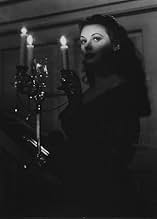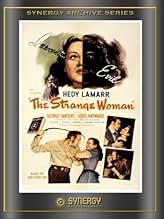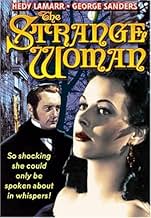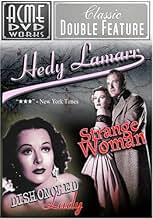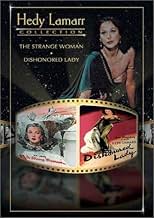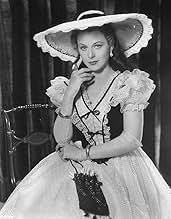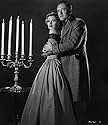CALIFICACIÓN DE IMDb
6.5/10
2.7 k
TU CALIFICACIÓN
En la Nueva Inglaterra de 1820, Jenny Hager, una bella, pobre y manipuladora joven, se casa con el rico Isaiah Poster, y seduce a su hijo y al capataz de la empresa.En la Nueva Inglaterra de 1820, Jenny Hager, una bella, pobre y manipuladora joven, se casa con el rico Isaiah Poster, y seduce a su hijo y al capataz de la empresa.En la Nueva Inglaterra de 1820, Jenny Hager, una bella, pobre y manipuladora joven, se casa con el rico Isaiah Poster, y seduce a su hijo y al capataz de la empresa.
- Dirección
- Guionistas
- Elenco
Ed Agresti
- Congregation Member
- (sin créditos)
John Alban
- Congregation Member
- (sin créditos)
Fred Aldrich
- Sailor in Saloon
- (sin créditos)
Jessie Arnold
- Mrs. Thatcher
- (sin créditos)
Frank Baker
- Congregation Member
- (sin créditos)
Edward Biby
- Mr. Partridge
- (sin créditos)
Opiniones destacadas
What a story and well acted. Hedy as a teenager and then into a grown woman. She was fantastic looking and fantastic in it. I thought George Sanders, whom I admired as an actor was miscast though. Louis Hayward was excellent as the weak son. In fact everyone in it was well cast. Too bad it wasn't in color, or done by a major studio. I could of sworn the little girl that portrays Hedy as a child was also fantastic for her age. She even looked like Hedy may of looked like at that age. Definitely worth watching.
Hedy Lamarr and Egar G. Ulmer. OK. It really did happen, improbable as the pairing seems.
She is very convincing as the daughter of a drunk who wants to dominate men and the society that squashed her when she was a child. It seems to me that her father speaks with a Scottish burr and that she does very briefly. The story might better have been changed so that he was an immigrant whose accent would be more consistent with th4e luscious Ms. Lamarr's own.
Nevertheless, it is atmospheric and very troubling. She marries an older man and immediately starts out in pursuit of his son. She gets the son and throws him over (a bit improbably) for Gweorge Sanders, wearing mutton chop sideburns here.
It's not Ulmer'best -- that might be his "Hamlet"pdate "Strange Illusion." But it is very good and it is one of the best performances ever given by Ms. Lamarr.
She is very convincing as the daughter of a drunk who wants to dominate men and the society that squashed her when she was a child. It seems to me that her father speaks with a Scottish burr and that she does very briefly. The story might better have been changed so that he was an immigrant whose accent would be more consistent with th4e luscious Ms. Lamarr's own.
Nevertheless, it is atmospheric and very troubling. She marries an older man and immediately starts out in pursuit of his son. She gets the son and throws him over (a bit improbably) for Gweorge Sanders, wearing mutton chop sideburns here.
It's not Ulmer'best -- that might be his "Hamlet"pdate "Strange Illusion." But it is very good and it is one of the best performances ever given by Ms. Lamarr.
An 1820's vixen climbs her way maliciously up the social ladder.
The movie's got the gloss and the casting of a top studio production, maybe TCF. But it's not. Instead, the film is an independent production with Lamarr as a co-producer. I mention this because the result looks tailor-made for a Lamarr career move; at the same time, she does manage to prove she's more than just Hollywood's perfect face. Here, her conniving little vixen (Jenny) transits a number of emotional stages and male victims in fairly convincing style. However, unless I missed something, Jenny's inner guile fails to show up in any of the many close-ups. As a result, Jenny's deceit remains mainly in the script—the one performance flaw.
The movie itself is an atmospheric potboiler, thanks to stylist Edgar Ulmer and art director Remisoff. The scenes may remain stage-bound, but the overall effect is compelling, a triumph of b&w expressiveness. Note too how the scenes get steadily darker as the film progresses and Jenny gets closer to the expected reckoning. Even when the screenplay meanders, which does slow things down, the visuals remain smoothly engaging. Then too, the logging camp setting should have been rethought. The sophisticated Sanders is simply not an outdoor type. Still, wonder of wonders, two of cinema's favorite cerebral baddies, Sanders and Brooke, get sympathetic roles, for a change. Actually, I expected Sanders to break into a cynical sneer at any moment, and maybe Brooke to revert to type with an icy glare. Anyway, it is an interesting cast, down to Hayward as the weakling Ephraim and little Jo Ann Marlowe as the meanest girl since Patty McCormack's Bad Seed (1956).
I don't know if the film resulted in the kind of career break Lamarr was likely looking for, but it remains an entertaining morality tale, despite a spotty script and stage-bound settings.
The movie's got the gloss and the casting of a top studio production, maybe TCF. But it's not. Instead, the film is an independent production with Lamarr as a co-producer. I mention this because the result looks tailor-made for a Lamarr career move; at the same time, she does manage to prove she's more than just Hollywood's perfect face. Here, her conniving little vixen (Jenny) transits a number of emotional stages and male victims in fairly convincing style. However, unless I missed something, Jenny's inner guile fails to show up in any of the many close-ups. As a result, Jenny's deceit remains mainly in the script—the one performance flaw.
The movie itself is an atmospheric potboiler, thanks to stylist Edgar Ulmer and art director Remisoff. The scenes may remain stage-bound, but the overall effect is compelling, a triumph of b&w expressiveness. Note too how the scenes get steadily darker as the film progresses and Jenny gets closer to the expected reckoning. Even when the screenplay meanders, which does slow things down, the visuals remain smoothly engaging. Then too, the logging camp setting should have been rethought. The sophisticated Sanders is simply not an outdoor type. Still, wonder of wonders, two of cinema's favorite cerebral baddies, Sanders and Brooke, get sympathetic roles, for a change. Actually, I expected Sanders to break into a cynical sneer at any moment, and maybe Brooke to revert to type with an icy glare. Anyway, it is an interesting cast, down to Hayward as the weakling Ephraim and little Jo Ann Marlowe as the meanest girl since Patty McCormack's Bad Seed (1956).
I don't know if the film resulted in the kind of career break Lamarr was likely looking for, but it remains an entertaining morality tale, despite a spotty script and stage-bound settings.
An obscure film which, because of surprising creative touches in directing, acting and editing, should be shown more often: more than a potboiler, more than a "women's picture" that did not happen to star Bette Davis or Joan Crawford, it offers an engaging story, characters of substance and - except for a convenient and contrived ending - an honest portrayal of people caught in a web of circumstances and emotions they cannot control. Aside from the glitter and sweep, it has more similarities to than differences from "Gone With the Wind."
This may be Hedy Lamarr's most challenging role, and she acquits herself quite well. George Sanders appears infrequently as a sympathetic character, but even he is victimized by the Scarlett O'Hara-like wiles of Hedy. That both of these performers have accents that are not suggestive of born-and-bred Maine residents should not constitute more than a minor annoyance. The picture has more than enough offsetting merits.
This may be Hedy Lamarr's most challenging role, and she acquits herself quite well. George Sanders appears infrequently as a sympathetic character, but even he is victimized by the Scarlett O'Hara-like wiles of Hedy. That both of these performers have accents that are not suggestive of born-and-bred Maine residents should not constitute more than a minor annoyance. The picture has more than enough offsetting merits.
In the era of psychoanalysis we are forced to look at a figure like the one in this film in a different way. There was a time when villains were at the melodramatic best and we could see them as one dimensional. This young woman is the product alcoholism and manipulation. She has good and she has bad. The bad usually wins out, but then she withdraws into herself, trying to be an ideal. Her relationships with men are certainly influenced by the abusive father from whom she must escape. She toys with men like playthings. She is extraordinarily beautiful. I hadn't ever really seen a Hedy Lamarr film. She about as striking as one can be. It seems that in this era dark haired women were often cast as vixens. She has that role but overcomes it with an excellent performance. It is a nice period piece. It is a little predictable at times, but the wonderful cinematography really pulls it along.
¿Sabías que…?
- TriviaExecutive producer Hunt Stromberg declared his dissatisfaction with the original opening sequence of Edgar G. Ulmer's own daughter Arianne Ulmer who played the young Jenny - she was purportedly not nasty enough - and so he and Hedy Lamarr enlisted Douglas Sirk to re-shoot the scenes using Jo Ann Marlowe who had appeared in Sirk's own Vidocq, el bribón de París (1946) earlier that year, and who had also featured as Joan Crawford's daughter Kay in Michael Curtiz' El suplicio de una madre (1945).
- ErroresEphraim paints "Nöel" rather than the correct "Noël."
- Citas
Lena Tempest: Honey, listen, with your looks you don't have to worry. You can get the youngest and best-looking man on the pier.
Jenny Hager: I don't want the youngest. I want the richest.
- Versiones alternativasFlor de insidia (1946). Restoration Produced by Jeff Joseph/SabuCat. Digital scan by Film & Video Transfer, Chatsworth, CA. Cineaste Restoration - Thad Komorowski.. Final Conforming & Cleanup by The Finishing Touch. The Strange Woman (Restored Version) copyright 2020 Jeff Joseph/SabuCat.
- ConexionesFeatured in Edgar G. Ulmer: The Man Off-Screen (2004)
- Bandas sonorasWhat Can You Do with a Drunken Sailor?
Traditional
Early 19th Century sea chanty
[Heard in tavern]
Selecciones populares
Inicia sesión para calificar y agrega a la lista de videos para obtener recomendaciones personalizadas
- How long is The Strange Woman?Con tecnología de Alexa
Detalles
- Fecha de lanzamiento
- País de origen
- Sitios oficiales
- Idioma
- También se conoce como
- The Strange Woman
- Locaciones de filmación
- Productoras
- Ver más créditos de la compañía en IMDbPro
- Tiempo de ejecución1 hora 40 minutos
- Color
- Relación de aspecto
- 1.37 : 1
Contribuir a esta página
Sugiere una edición o agrega el contenido que falta

Principales brechas de datos
By what name was Flor de insidia (1946) officially released in India in English?
Responda
